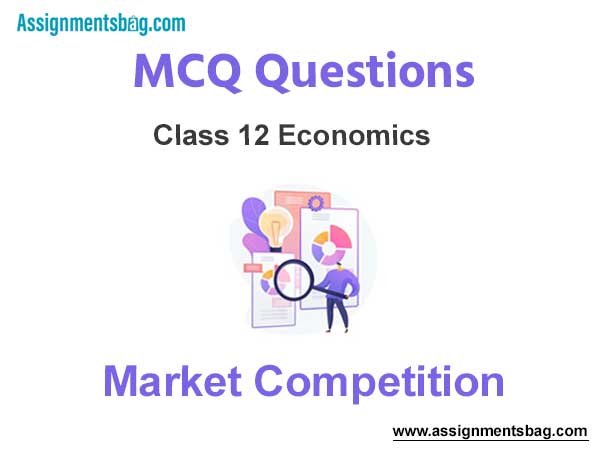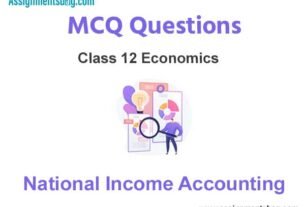Please refer to MCQ Questions Chapter 5 Market Competition Class 12 Economics with answers provided below. These multiple-choice questions have been developed based on the latest NCERT book for class 12 Economics issued for the current academic year. We have provided MCQ Questions for Class 12 Economics for all chapters on our website. Students should learn the objective based questions for Chapter 5 Market Competition in Class 12 Economics provided below to get more marks in exams.
Chapter 5 Market Competition MCQ Questions
Please refer to the following Chapter 5 Market Competition MCQ Questions Class 12 Economics with solutions for all important topics in the chapter.
MCQ Questions Answers for Chapter 5 Market Competition Class 12 Economics
Question: Which is a reason of change in demand ?
(a) Change in Consumer’s Income
(b) Change in Prices of Related Goods
(c) Population increase
(d) All the above
Answer
D
Question: Market Price is found in:
(a) Short Period Market
(b) Long Period Market
(c) Very Long Period Market
(d) None of these
Answer
A
Question: Market price is associated with:
(a) Price of very short period
(b) Normal price
(c) Permanent price
(d) All of these
Answer
A
Question: In perfect competition, a firm:
(a) Determines price
(b) Obtains price
(c) Both (a) and (b)
(d) None of these
Answer
B
Question: Which is not a condition for equilibrium of a monopoly form ?
(a) Average Revenue = Marginal Cost
(b) Marginal Revenue = Marginal Cost
(c) Marginal Cost should cut the Marginal Revenue Curve from below
(d) Both (b) and (c)
Answer
D
Question: A Seller Cannot influence the market price under:
(a) Perfect Competition
(b) Monopoly
(c) Monopolistic Competition
(d) All of these
Answer
A
Question: Which is the component of factor price determination ?
(a) Rent
(b) Wages
(c) Interest
(d) All of these
Answer
D
Question: None of these Rent is = ?
(a) Actual Income – Transfer Earnings
(b) Actual Income + Transfer Earnings
(c) Transfer Earnings
(d) None of these
Answer
A
Question: Main feature of perfectly competitive market is:
(a) Uniform price
(b) Homogeneous product
(c) Large number of buyers and sellers
(d) All of the above.
Answer
D
Question: There is inverse relation between demand and price of goods in:
(a) Only monopoly
(b) Only monopolistic competition
(c) Both (a) and (b)
(d) Only perfect competition.
Answer
D
Question: Not a condition of equilibrium of monopoly firm:
(a) Average revenue = Marginal revenue
(b) Marginal revenue = Marginal cost
(c) Marginal cost curve cuts marginal revenue curve from downwards.
(d) Both (b) and (c).
Answer
A
Question: Demand curve of a firm is perfectly elastic in:
(a) Perfect competition
(b) Monopoly
(c) Monopolistic competition
(d) Oligopoly.
Answer
A
Question: Minimum support price of wheat is called:
(a) Price ceiling
(b) Price floor
(c) Market price
(d) Equilibrium price.
Answer
B
Questions: Which factors help in the determination of equilibrium price:
(a) Demand
(b) Supply
(c) Both (a) and (b)
(d) None of the above.
Answer
D
Question: Excess demand can be seen in:
(a) Fixed market price
(b) Lowest fixed price
(c) Highest fixed price
(d) None of these.
Answer
C
Question: When will increase in supply bring down the price, leaving the quantity demanded unchanged?
a) When demand for the commodity is perfectly elastic
b) When demand for the commodity is perfectly inelastic
c) When demand for the commodity is less elastic
d) When demand for the commodity is more elastic
Answer
B
Question: What will be the effect on equilibrium price if supply is decreased without any change in demand?
a) No change in price
b) Price will fall
c) Price will rise
d) None of these
Answer
B
Question: Charging different prices from different buyers for the same good is called :
a) Price extension
b) Price contraction
c) Price discrimination
d) Price control
Answer
C
Question: In the context of monopolistic competition one of the following statements is correct?
a) Firm has full control over price
b) Horizontal straight line in demand curve of the firm
c) Freedom of entry and exit
d) Selling costs do not exist
Answer
C
Question: Which characteristic of monopolistic competition is compatible with monopoly?
a) One seller and large number of buyers
b) Full control over price
c) Demand curve slopes downward
d) Freedom of entry and exit
Answer
C
Question: Which characteristic of monopolistic competition is compatible with monopoly?
a) One seller and large number of buyers
b) Full control over price
c) Demand curve slopes downward
d) Freedom of entry and exit
Answer
C
Question: If the demand curve of a firm is a horizontal straight line :
a) A firm can sell any amount at the existing price
b) A firm can sell only a specified amount at the existing price
c) All firms will sell equal amount of a commodity
d) Firms can differentiate their product
Answer
A
Question: Compared with monopolistic competition, a firm’s demand curve under monopoly is :
a) Equally elastic
b) Less elastic
c) More elastic
d) Infinitely elastic
Answer
B
Question: A market situation in which there are only two producers is called :
a) Monopoly
b) Duopoly
c) Oligopoly
d) None of these
Answer
C
Question: A market situation in which there are only two producers is called :
a) Monopoly
b) Duopoly
c) Oligopoly
d) None of these
Answer
B
Question: In monopolistic competition the products are:
a) Homogeneous only
b) Homogeneous supported with advertisement
c) Differentiated only
d) Differentiated supported with advertisement
Answer
D
Question: What is the shape of the average revenue curve in perfect competition?
a) Horizontal straight line
b) Vertical straight line
c) Rectangular hyperbola
d) Downward to the right
Answer
A
Question: Under perfect competition ‘Average Revenue’ and ‘Marginal Revenue’ are indicated by :
a) A common horizontal straight line
b) A common vertical straight line
c) A common rectangular hyperbola
d) Different lines sloping downward
Answer
A
Question: The market price is related to:
a) Short period
b) Very short period
c) Long period
d) Very long period
Answer
B
Question: What is the shape of the average revenue curve in perfect competition?
a) Horizontal straight line
b) Vertical straight line
c) Rectangular hyperbola
d) Downward to the right
Answer
A
Question: Under perfect competition, equilibrium price of the commodity is determined by:
a) Demand for the commodity alone
b) Supply of commodity alone
c) Both demand and supply
d) The government
Answer
C
Question: Supply being perfectly inelastic, what will be the effect of increase or decrease in demand on price and equilibrium quantity?
a) Price increases or decreases respectively
b) No effect on equilibrium quantity
c) Both (a) and (b)
d) None of these
Answer
C
Question: The period of time, when supply is fully adjusted to change in demand is called:
a) Short – period
b) Very short- period
c) Mid-period
d) long- period
Answer
D
Question: Market supply curve of perishable goods is a vertical straight line parallel to Y- axis. It happens in which of the following periods?
a) Long- period
b) Short – period
c) Very short- period
d) Market- period
Answer
C
Question: What would price ceiling lead to when the maximum price is fixed lower than the equal price?
a) Excess demand
b) Excess supply
c) Deficient demand
d) Deficient supply
Answer
A
Question: If demand for a product falls, equilibrium price will :
a) Fall
b) Rise
c) Either of the two
d) Neither of the two
Answer
A
Question: Under perfect competition ‘Average Revenue’ and ‘Marginal Revenue’ are indicated by :
a) A common horizontal straight line
b) A common vertical straight line
c) A common rectangular hyperbola
d) Different lines sloping downward
Answer
A
Question: In which kind of market, a firm is a price- taker?
a) Perfect Competition
b) Monopoly
c) Monopolistic competition
d) Oligopoly
Answer
A
Question: Firm’s demand cuve under monopoly shows:
a) No relationship between price and demand
b) Inverse relationship between price and demand
c) Positive relationship between price and demand
d) None of these
Answer
B

We hope you liked the above provided MCQ Questions Chapter 5 Market Competition Class 12 Economics with solutions. If you have any questions please ask us in the comments box below.


